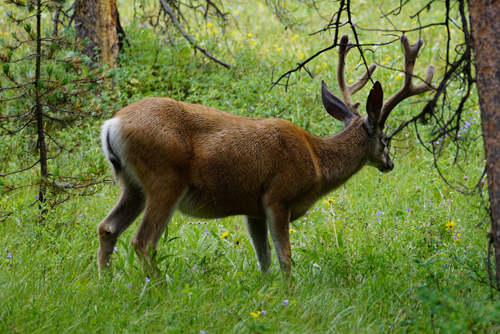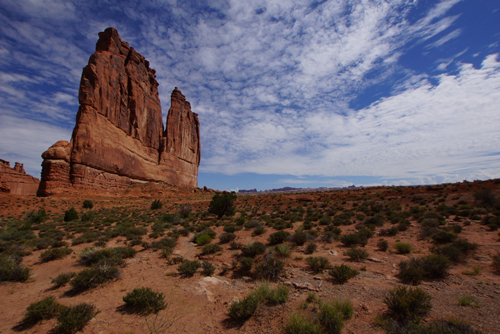We were on our way to visit Grand Teton and Yellowstone National Parks – Jackson was our starting point.
The drive to Jackson or Jackson Hole, as it is mistakenly known, was varied. The initial stage being warm and dry, with rocky outcrops and fields of wheat along the way. Then we hit the alpine regions with towering pine forests, raging rivers, log cabins and ski fields.
The temperature also dropped dramatically and by the time we reached Jackson we were ready to pull the long pants and jumpers out of our bags.
It rained all night and was still overcast the next morning.
Realising that there was far too much to see in the time we had allowed, we booked two extra nights, this time near the west entrance to Yellowstone. We then decided to spend our day near Jackson, exploring Grand Teton first.
Jackson is in the Jackson Hole Valley, Wyoming and attracts tourist in both summer and winter, with world class ski fields and the National Parks on its doorstep.
It looks a little like the old Wild West towns from the movies but behind the timber facades are restaurants, coffee shops and boutiques selling everything from T-Shirts to fine art.
One of the unique attractions ofJackson are the large arches, of shed elk antlers, at the entrance to the town park. Local scouts also collect these from the National Elk Refuge, which is close by, and sell them to the hordes tourists that visit the town.
Jackson was one of the few towns to embrace the role of women in west.
It was originally named by Margaret Simpson, after the mountain man David ‘Davie’ Jackson, in 1894 and at one stage even had a female sherif. In 1920 Jackson elected the first all-woman city council.
Grand Teton is only 16km south of Yellowstone and is dominated by the 64km long Teton Range.
The range was named by French trappers in the early 1800s and was originally called Les Trois Tétons or The Three Teats.
The female influence in the area continues.
We walked along the shore of Jenny Lake and discovered an elk grazing peacefully in a meadow. I am not sure who go the bigger shock.
Grand Teton National Park is one of the largest intact mid-latitude ecosystems in the world, with an abundance of wild life and wild flowers.
Established in 1872 by the US Congress and signed into law by Ulysses S Grant, Yellowstone was the the first National Park in the US and the world.
Yellowstone is inside a giant caldera and there’s thermal activity at every turn. Steam seems to rise from the most unlikely places.
It was at Mud Volcano that I learnt the difference between roiling and boiling. Although the thermal mud ponds seem to be boiling they only look like that because of the steam that is rising from the fissures below.
This simulated boiling is called roiling.
On our first day in the park we came up from Jackson and drove in a loop. Starting from West Thumb we travelled anti clockwise past Yellowstone Lake, through Hayden Valley to Canyon Village, then through Norris and Madison and back to West Yellowstone.
The weather fluctuated from overcast to rain.
The next day it rained less but the weather was still unreliable.
This time we came from West Yellowstone and made a clockwise loop, on the northern road, past Gibbon Falls to Mammoth Hot Springs, Tower-Roosevelt, past Mount Washburn to Canyon River and the Upper and Lower Falls. We then completed the trip back again through Norris and Madison.
Our circuit took a lot longer than expected, as we were held up with roadworks and an emergency involving a helicopter landing in a car park just in front of us.
From Yellowstone West we drove to Boise, the capitol of Idaho and then on to Portland in Oregon.
We had a coffee break in Idaho Falls a sleepy little place with the Snake River cascading through the centre of town.
The geography in this area of North America is stunning. Rivers raged and there seems to be an endless supply of spectacular scenery around every bend in the road.
Most people in the US seem to finish their meals in about 45 minutes – we take much longer.
This gives us a great opportunity to be spectators of more than one table.
Half the fun of being a traveller is observing life and living in different countries.
The US is a fascinating society and their food a conundrum. The serves are huge and stacked with carbs – fries are a staple. There is no subtlety in the flavors with fresh herbs and spices playing a fleeting role. Yet the choice of sides and extras goes on and on.
There are the Gastro Pubs and fine dining but the average person, when eating out, has a poor quality selection to chose from.
Then there’s what’s been done to Italian cuisine.
Italian has become the ‘World Food’ because it’s simple, easy to prepare, flavorsome and, when eaten properly, well balanced.
In the US these criteria have been abandoned. Their take on Italian has been complicated beyond belief.
The sauce has become so complex and so abundant that the pasta is overwhelmed. The basic Italian herbs of oregano, basil and thyme have all been forgotten – as has garlic and even olive oil.
I won’t even go into what has been done to pizza.
Every restaurant seems to try and out-maneuver the next with their toppings.
Comfort food, with high carbs, high sugar and mega serves seems to be the most acceptable.
Cheese seems to be the main additive on all sorts of food. We even had it on fries from Idaho, the home of potatoes in North America.
Yet try and find a cheese platter for desert and you’ll fail.
There are always the exceptions and we found some great ones. These were mainly associated with the craft brewery scene, where the food was as important as the beer and, surprisingly, the wine.
These establishments were frequented by a younger generation who seem to place quality above quantity.
In Boise, Idaho, I actually witnessed a guy leaving food on his plate.
While we might whinge about the food, most of the hotels and motels we stayed at were excellent. Toilets or ‘bathrooms’ were impeccable, especially compared to some places we have been.
Everything also works.
The water is hot, showers heads spray water on you, not the floor or ceiling, and nothing leaks.
There is soap, shampoo, towels and in most cases a hair dryer in the room. What wasn’t provided was readily available at reception.












